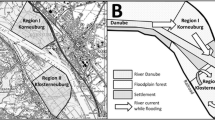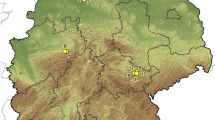Abstract
The effect of rainfall pattern on tick challenge was investigated at Kyle Recreational Park, Zimbabwe, from 1991 to 1992 using drag and removal plot methods to sample environmental tick density. The abundance of adults and nymphs of the brown ear-tick Rhipicephalus appendiculatus and larvae of the bont tick Amblyomma hebraeum was positively correlated with monthly rainfall, whereas no relationship with rainfall was revealed for larval R. appendiculatus, adults of the red-legged tick R. evertsi, or larvae of the blue tick Boophilus decoloratus. A comparison between 1991 (490 mm rainfall) and the drought year of 1992 (161 mm) revealed significant differences in the abundance of R. appendiculatus, A. hebraeum, and B. decoloratus. During the wet season, R. appendiculatus adults were 2–3 time more numerous in the environment during the higher rainfall year of 1991. A. hebraeum larval abundance exhibited a similar pattern to that of R. appendiculatus adults, but B. decoloratus larvae were more abundant in the drought year of 1992 during both the wet and dry seasons. Comparable tick abundance data collected at Kyle during the above-average rainfall years of 1975–1977 (mean = 1029 mm) were compared with tick challenge during the below-average rainfall years of 1991–1992 (mean = 326 mm). In grassland sand habitat and all habitats combined R. appendiculatus adults, nymphs, and larvae were much more abundant during the high rainfall years. In contrast, larvae of B. decoloratus were more numerous during the drier years. A. hebraeum larvae were also more abundant during the drier years. The strong positive correlation of adult R. appendiculatus abundance with rainfall and the coincidence of increased adult tick challenge with increased rainfall indicates that adult R. appendiculatus tick burden on hosts would be heaviest during the wet season and high rainfall years.
Similar content being viewed by others
References
Feldman, D.S., Gagnon, J., Hofmann, R. and Simpson, J., 1990. StatView II SE+Graphics. The Solutions for Data Analysis and Presentation Graphics. Abacus Concepts, Berkely, CA, 247 pp.
Hart, B.L., 1990. Behavioral adaptations to pathogens and parasites: five strategies. Neurosci. Biobehav. Rev., 14: 273–294.
Hart, B.L., Hart, L.A., Mooring, M.S. and Olubayo, R., 1992. Biological basis of grooming behaviour in antelope: The body size, vigilance and habitat principles. Anim. Behav., 44: 615–631.
Horak, I.G., 1982. Parasites of domestic and wild animals in South Africa. XV. The seasonal prevalence of ectoparasites on impala and cattle in the Northern Transvaal. Onderstepoort J. Vet. Res., 49: 85–93.
Kaiser, M.N., Sutherst, R.W., and Bourne, A.S., 1991. Tick (Acarina: Ixodidae) infestations on zebu cattle in northern Uganda. Bull. Entomol. Res., 81: 257–262.
Lightfoot, C.J. and Norval, R.A.I., 1981. Tick problems in wildlife in Zimbabwe. 1. The effects of tick parasitism on wild ungulates. S. Afr. J. Wildl. Res., 11: 41–45.
Londt, J.G.H. and Whitehead, G.B., 1972. Ecological studies of larval ticks in South Africa. (Acarina: Ixodidae). Parasitol., 65: 469–490.
MacIvor, K.M., Horak, I.G., Holton, K.C. and Petney, T.N., 1987. A comparison of live and destructive sampling methods of determining the size of parasitic tick populations. Exp. Appl. Acarol., 3: 131–143.
Mason, C.A. and Norval, R.A.I., 1980. The ticks of Zimbabwe. I. The genus Boophilus. Zimbabwe Vet. J., 11: 36–43.
McCulloch, B., Kalaye, W.J., Tungaraza, B., Suda, Q.J. and Mbasha, E.M.S., 1968. A study of the life history of the tick Rhipicephalus appendiculatus — the main vector of East Coast Fever — with reference to its behaviour under field conditions and with regard to its control in Sukumaland, Tanzania. Bull. Epizoot. Dis. Afr., 16: 477–500.
Minshull, J.I., 1981a. Seasonal occurrence, habitat distribution and host range of four ixodid tick species at Kyle Recreational Park in south eastern Zimbabwe. Zimbabwe Vet. J., 12: 58–63.
Minshull, J.I., 1981b. A study of Rhipicephalus appendiculatus Neumann, 1901 (the brown ear tick) in Zimbabwe. M.Phil. Thesis, University of Zimbabwe, 116 pp.
Minshull, J.I. and Norval, R.A.I., 1982. Factors influencing the spatial distribution of Rhipicephalus appendiculatus in Kyle Recreational Park, Zimbabwe. S. Afr. J. Wildl. Res., 12: 118–123.
Mooring, M.S., 1994. The effect of tick challenge on grooming rate by impala. Anim. Behav. (In press).
Mooring, M.S. and Hart, B.L., 1994. Differential grooming rate and tick load of territorial male and female impala, Aepyceros melampus. Behav. Ecol. (In press).
Mulilo, J.B., 1985. Species quantification and seasonal abundance of ticks (Acarina: Ixodidae) in the eastern province of Zambia: ticks from cattle. Tropical Pest Management, 31: 204–207.
Nelson, W.A., Bell, J.F., Clifford, C.M. & Keirans, J.E. 1977. Interaction of ectoparasites and their hosts. J. Med. Entomol., 13, 389–428.
Norval, R.A.I., 1977a. Ecology of the tick Amblyomma hebraeum Koch in the eastern Cape province of South Africa. I. Distribution and seasonal activity. J. Parasitol., 63: 734–739.
Norval, R.A.I., 1977b. Studies on the ecology of the tick Amblyomma hebraeum Koch in the eastern Cape Province of South Africa. II. Survival and development. J. Parasitol., 63: 740–747.
Norval, R.A.I., 1978. Repeated feeding of Amblyomma hebraeum (Acarina: Ixodidae) immatures on laboratory hosts. Host effects on tick yield, engorged weight and engorgement period. J. Parasitol., 64: 910–917.
Norval, R.A.I., 1979. The limiting effect of host availability for the immature stages on population growth in economically important ixodid ticks. J. Parasitol., 65: 285–287.
Norval, R.A.I., 1981. The ticks of Zimbabwe. III. Rhipicephalus evertsi evertsi. Zimbabwe Vet. J., 12: 31–35.
Norval, R.A.I., Andrew, H.R. and Meltzer, M.I., 1991. Seasonal occurrence of the bont tick (Amblyomma hebraeum) in the southern lowveld of Zimbabwe. Exp. Appl. Acarol., 13: 81–96.
Norval, R.A.I. and Lightfoot, C.J., 1982. Tick problems in wildlife in Zimbabwe. Factors influencing the occurrence and abundance of Rhipicephalus appendiculatus. Zimbabwe Vet. J., 13: 11–20.
Norval, R.A.I. and Short, N.J., 1979. Seasonal occurrence of larvae of four species of ixodid ticks in the highveld of Zimbabwe. Rhod. Vet. J., 10: 88–91.
Olubayo, R.O., Jono, J., Orinda, G., Groothenhuis, J.G. and Hart, B.L., 1993. Comparative differences in densities of adult ticks as a function of body size on some East African antelopes. Afr. J. Ecol., 31: 26–34.
Pegram, R.G., Perry, B.D., Musisi, F.L. and Mwanaumo, B., 1986. Ecology and phenology of ticks in Zambia: seasonal dynamics on cattle. Exp. Appl. Acarol., 2: 25–45.
Pegram, R.G., Lemche, J., Chizyuka, H.G.B., Sutherst, R.W., Floyd, R.B., Kerr, J.D. and McCosker, P.J., 1989. Ecological aspects of cattle tick control in central Zambia. Med. Vet. Entomol., 3: 307–312.
Petney, T.N., Van Ark, H., and Spickett, A.M., 1990. On sampling tick populations: the problem of overdispersion. Onderstepoort J. Vet. Res., 57: 123–127.
Punyua, D.K., Newson, R.M, and Mutinga, M.J., 1984. Diurnal and seasonal activity of unfed adult Rhipicephalus appendiculatus (Acarina: Ixodidae) in relation to some intrinsic and extrinsic factors. 2. Factors affecting vertical distribution of ticks in the habitat. Insect Sci. Applic., 5: 245–246.
Punyua, D.K., Newson, R.M, and Mutinga, M.J., 1985a. Diurnal and seasonal activity of unfed adult Rhipicephalus appendiculatus (Acarina: Ixodidae) in relation to some intrinsic and extrinsic factors. 1. Factors regulating activity. Insect Sci. Applic., 6: 63–70.
Punyua, D.K., Newson, R.M, and Mutinga, M.J., 1985b. Diurnal and seasonal activity of unfed adult Rhipicephalus appendiculatus (Acarina: Ixodidae) in relation to some intrinsic and extrinsic factors. 3. Daily changes in water content. Insect Sci. Applic., 6: 71–73.
Rechav, Y., 1982. Dynamics of tick populations (Acari: Ixodidae) in the eastern Cape Province of South Africa. J. Med. Entomol., 19: 679–700.
Riek, R.F., 1956. Factors influencing the susceptibility of cattle to tick infestation. Australian Veterinary Journal, 32: 204–209.
Short, N.J. and Norval, R.A.I., 1981a. The seasonal activity of Rhipicephalus appendiculatus Neumann 1901 (Acarina: Ixodidae) in the highveld of Zimbabwe Rhodesia. J. Parasitol., 67: 77–84.
Short, N.J. and Norval, R.A.I., 1981b. Regulation of seasonal occurrence in the tick Rhipicephalus appendiculatus Neumann, 1901. Trop. Anim. Hlth. Prod., 13: 19–26.
Siegel, S. and Castellan, N.J., 1988. Nonparametric Statistics for the Behavioral Sciences. McGraw-Hill, New York, NY, 399 pp.
Smith, M.W., 1969. Variations in tick species and populations in the Bugisu District of Uganda. Bull. Epizoot. Dis. Afr., 17: 77–105.
Welch, D.A. and Samuel, W.M., 1989. Evaluation of random sampling for estimating density of winter ticks (Dermacentor albipictus) on moose (Alces alces) hides. Int. J. Parasitol., 19: 691–693.
Wikel, S.K. 1984. Immunomodulation of host responses to ectoparasite infestation. An overview. Vet. Parasitol., 14, 321–339.
Willadsen, P. 1980. Immunity to ticks. Adv. Parasitol., 18, 293–313.
Wilson, S.G., 1946. Seasonal occurrence of Ixodidae on cattle in Northern Province, Nyasaland. Parasitol., 37: 118–125.
Yeoman, G.H., 1966. Field vector studies of epizootic East Coast Fever II. Seasonal studies of R. appendiculatus on bovine and non-bovine hosts in East Coast Fever enzootic, epizootic and free areas. Bull. Epizoot. Dis. Afr., 14: 113–140.
Author information
Authors and Affiliations
Rights and permissions
About this article
Cite this article
Mooring, M.S., Mazhowu, W. & Scott, C.A. The effect of rainfall on tick challenge at Kyle Recreational Park, Zimbabwe. Exp Appl Acarol 18, 507–520 (1994). https://doi.org/10.1007/BF00058934
Accepted:
Issue Date:
DOI: https://doi.org/10.1007/BF00058934




